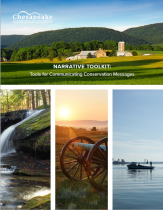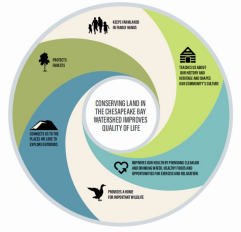A new Narrative Toolkit provides a series of tools for uniting and bolstering communications about land conservation in the communities and regions of the Chesapeake Bay watershed. (Image: Spitfire Strategies)
 Achieving conservation goals requires continued support for public land protection programs, increased private sector investment, and other new sources of conservation financing. All of these depend on an engaged public, interested landowners, dedicated conservationists, and committed public officials.
Achieving conservation goals requires continued support for public land protection programs, increased private sector investment, and other new sources of conservation financing. All of these depend on an engaged public, interested landowners, dedicated conservationists, and committed public officials.
How can all of us most effectively communicate the value of conserving land in ways that bolster conservation efforts in the Chesapeake Bay watershed?
To answer this, the Partnership is releasing a new a Narrative Toolkit: Tools for Communicating Conservation Messages. The toolkit presents a shared narrative for uniting all of our efforts, as well as tools and resources for land conservation partners to use. It includes:
Step-by-step guidance for partners to tailor their own compelling and persuasive messaging, based on the narrative, for key audiences;
Guidelines for partners to incorporate the narrative into all day-to-day communication efforts;
Tips for tailoring the narrative to varying geographic scales; and
Recommendations for utilizing and tailoring visual elements that convey the narrative.
The toolkit was developed for the Partnership by Spitfire Strategies, with support from the Appalachian Trail Landscape Partnership, and the Eastern Shore Land Conservancy and the Agua Fund. It is based on a comprehensive research process which included: a materials review to identify how the Partnership and its members, and Appalachian Trail conservation partners, talk about their shared land conservation vision; a media scan to describe and understand the current narratives about land conservation in key regions; and stakeholder interviews with individuals representing the Partnership’s member organizations to identify key messages, regional challenges and ways to support members’ communication efforts. The Partnership also held workshops with land conservation practitioners in Maryland, Pennsylvania and Virginia to test and demonstrate the narrative and toolkit.
You can find the toolkit and links to various individual tools here.
Lightning Update is a regular communication of the Chesapeake Conservation Partnership. Any opinions expressed are those of the authors and do not necessarily reflect positions of the Partnership or member organizations.
To share a success story, news, or important event, send your information to:
Support for the Chesapeake Conservation Partnership is provided by:
National Park Service Chesapeake
EPA Chesapeake Bay Program
USDA Forest Service
Pennsylvania Department of Conservation & Natural Resources
Maryland Department of Natural Resources
Virginia Outdoors Foundation
US Fish & Wildlife Service
Chesapeake Conservancy
The Chesapeake Conservation Partnership is co-convened by:




